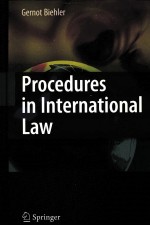

PROCEDURES IN INTERNATIONAL LAWPDF电子书下载
- 电子书积分:13 积分如何计算积分?
- 作 者:
- 出 版 社:SPRINGER
- 出版年份:2008
- ISBN:3540744975
- 页数:351 页
Chapter 1 A Procedural Perspective in Law 1
1.1 Law and Procedure 4
1.2 Essential Properties of Legal Procedures 6
1.2.1 The Legal Distinction Between Substance and Procedure 6
1.2.1.1 Imprisonment as Procedure 9
1.2.1.2 Non-enforceable Obligations Enforced:Specific Performance 9
1.2.1.3 Calculation of Damages as Procedure 11
1.2.1.4 Limitation Periods 14
1.2.1.5 Equitable Remedies as Procedural Law 15
1.2.1.6 Injunctions 21
1.2.1.7 Public Policy Exceptions and Political Considerations 22
1.2.1.8 Conclusions 30
1.2.2 The Public Character of Procedures 33
Chapter 2 Procedures in International Law 35
2.1 Lack of Compulsory Procedures 38
2.1.1 General Procedural Provisions in International Instruments 40
2.1.2 Different Features Regarding Non-state Party Procedures 46
2.2 Variety of Procedures 49
2.3 National and International Legal Procedures 54
2.3.1 National Procedural Law as International Law 54
2.3.2 General Character of Procedures 58
Chapter 3 The Quest and the Notion 59
3.1 Aim of the Inquiry 59
3.2 Empirical Approach 59
3.3 Form and Contents,Procedures and Law 61
Chapter 4 National Legal Procedures 63
4.1 Jurisdiction 64
4.2 Interest in International Jurisdiction 68
4.3 Delineation in International Jurisdiction-General Principles 68
4.3.1 The European Conventional Approach in Conflict 70
4.3.1.1 Application of the Convention 71
4.3.1.2 General Comment on the Application of the Convention 75
4.3.1.3 Effect of the European Conventional System 80
4.3.1.4 National Bases and Choice of Jurisdiction 81
4.3.1.5 Forum Selection Under the European Rules;Italian Torpedoes 83
4.3.2 The Effect of the European Approach Beyond Europe 91
4.4 The Global System 94
4.5 Basis of Jurisdiction in Different Countries 116
4.5.1 Jurisdiction 116
4.5.2 Service of Proceedings 135
4.5.2.1 Hague Convention 136
4.5.2.2 Council Regulation(EC)No 1348/2000 136
4.5.2.3 Lugano Convention 137
4.5.2.4 Noteworthy Domestic Provisions 137
4.5.2.5 Security for Costs 150
4.5.3 Recognition and Enforcement 150
4.5.3.1 Noteworthy Domestic Provisions 154
4.5.4 Conclusion 155
Chapter 5 Limiting National Jurisdiction by Procedural Means 157
5.1 Introduction 157
5.2 Act of State 161
5.3 Comity 166
5.4 Executive Certificates 174
5.5 Amicus Curiae Briefs 181
Chapter 6 Substantive International Law Before National Fora 185
6.1 Challenges in Applying International Law 185
6.1.1 Unalterable Procedures of National Courts 185
6.1.2 Conflict with the Floating Nature of International Law 186
6.1.3 Procedural Effects 188
6.2 Individual Applicants and Defendants 191
6.2.1 The Incidental Nature of International Law or Direct Effect 191
6.2.2 Indirect Application of International Law 193
6.2.2.1 Sanctions 193
6.2.2.1.1 UN Sanctions 194
6.2.2.1.2 US Sanctions Internationally Applied 203
6.2.2.2 Expropriation 205
6.2.3 Individuals and States 211
6.2.4 Locus Standi of the Individual 214
6.2.4.1 Political Contexts 214
6.2.4.2 Economic Interests 219
6.2.4.3 Fundamental and Human Rights 225
6.2.4.4 Diplomatic Protection 230
6.2.4.5 Tort Claims Against States Before National Courts 236
6.2.5 Proceedings by the Forum State 238
6.2.5.1 Criminal Prosecution 238
6.2.5.2 International Law as a Defence Before National Courts 245
6.2.5.3 Extradition 252
6.2.5.3.1 The Political Offence Exception 252
6.2.5.3.2 The Rule Against Double Jeopardy 255
6.2.5.3.3 The Rule of Specialty 258
6.2.5.3.4 Appropriate Forum 261
6.2.5.3.5 The European Arrest Warrant Procedure 262
6.2.6 Suing Foreign States Before a National Forum 264
6.2.6.1 The US Alien Tort Claims Act 1789 264
6.2.6.2 Tort and Torture 267
Chapter 7 International Legal Adjudication 273
7.1 Limits 275
7.1.1 Governing Agreements 275
7.1.2 Political Nature 275
7.1.3 No Binding Force or Stare Decisis Beyond the Parties 276
7.1.4 Enforcement Issues 276
7.2 Strengths of International Adjudication 278
7.3 The International Court of Justice 278
7.3.1 Jurisdiction and Proceedings 279
7.3.2 Binding Force of Judgments and Enforcement Procedures 280
7.3.3 Function and Labelling 282
7.3.4 Character of an Arbitral Award 283
7.3.5 Submission to Jurisdiction 285
7.3.6 The UN and Individuals Before the ICJ 286
7.4 The Court of the Commonwealth of Independent States 287
7.5 Other International Adjudicative Bodies and Their Procedures 288
7.5.1 The Effect of the Variety of International Adjudicating Bodies 289
Chapter 8 Alternative Methods of Dispute Resolution 295
8.1 The Means Listed in Article 33 of the UN Charter 296
8.2 Diplomatic Means as a Form of ADR in International Law 297
8.3 The Institutional Background of Diplomatic Settlement of Disputes 299
8.4 Good Offices 300
8.4.1 The UN Secretary General in the Turkish Republic of Northern Cyprus 301
8.4.2 The UN Secretary General in the"Rainbow Warrior"Case 302
8.5 Arbitration and the Permanent Court of Arbitration in The Hague 304
Chapter 9 Conflicts Between Adjudicators Applying International Law 309
9.1 An Emerging International Judicial System? 309
9.2 The Relationship Between National and International Law-an Introduction 312
9.3 Examples of Jurisdictional Conflicts 314
9.3.1 The Attitude of Domestic Courts in the US 314
9.3.2 Conflicts Between Treaty Provision and Contracts 320
9.4 A Disintegrationist Approach 325
9.4.1 The MOX Litigation 325
9.4.2 The Bosphorous Litigation 329
9.5 Methods of Regulating the Interaction Between International and National Courts 337
9.5.1 Same Issues and Same Parties 338
9.5.2 Choice of Forum Provisions 340
9.5.3 A Possible Future Model for Jurisdiction-Regulating Rules 340
Index 343
